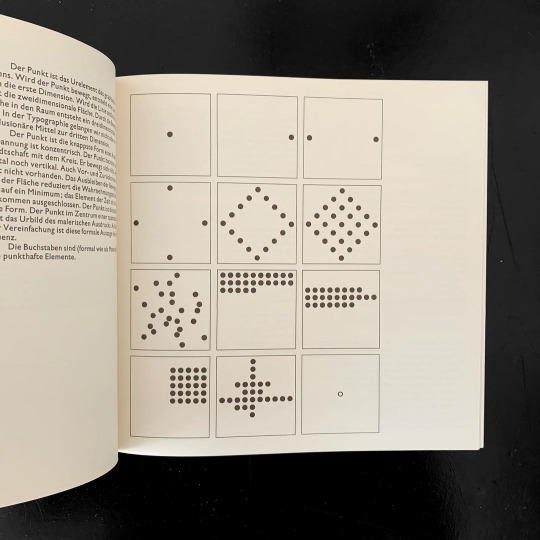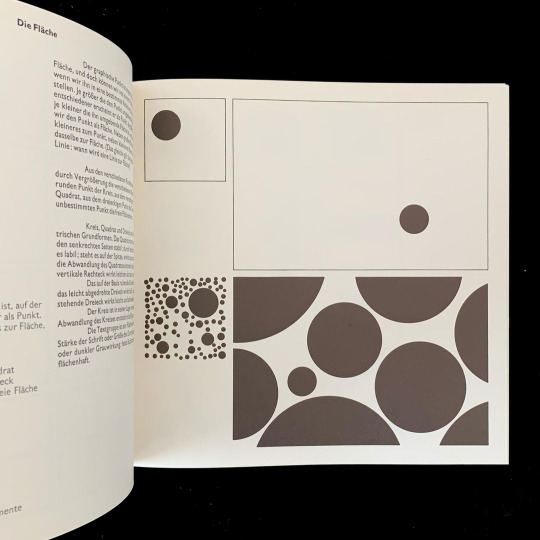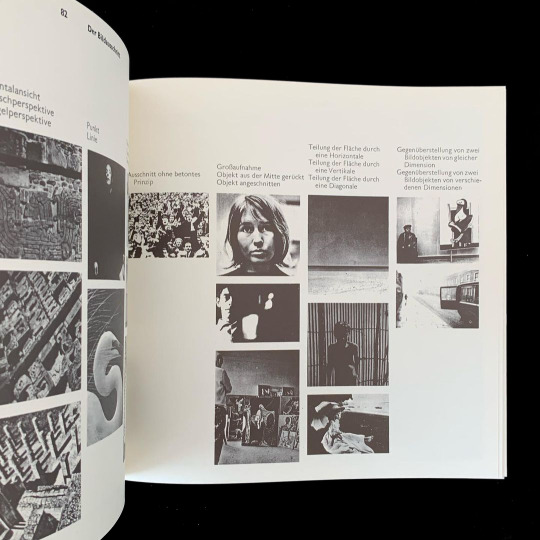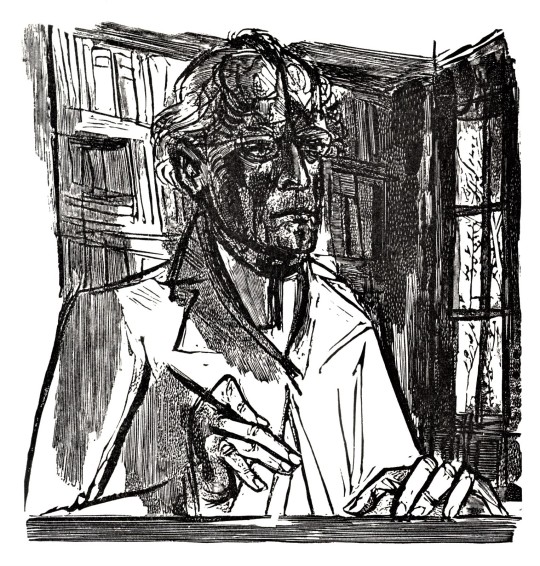#max caflisch
Text











It's Fine Press Friday!
In getting ready for the weekend, we present this 1967 German edition of Aesop's fables, Drei Dutzend Fabeln von Äsop, published in Bern by Angelus Druck, with 36 original woodcut illustrations by Swiss artist Felix Hoffmann (1911-1975). The book was designed by Swiss book and type designer Max Caflisch (1916-2004), typeset in Poliphilus Antiqua, and printed in an edition of 200 copies signed by the artist.
View more posts with illustrations by Felix Hoffmann.
View more editions of Aesop's Fables.
View more Fine Press Friday Posts.
#Fine Press Friday#fine press fridays#Felix Hoffmann#woodcuts#Aesop#Aesop's fables#Drei Dutzend Fabeln von Äsop#Angelus Druck#Max Caflisch#Max Caflisch (1916-2004)#typeset in Poliphilus Antiqua#fine press printing#fine press books
49 notes
·
View notes
Photo

text B
shakespeare, Love's Labor's Lost, act v, ii, 42. nice bit of irony : textura is black! —not fair.
set in linotype sabon next—vide ‹tschichold’s sabon›; the B is from linotype linotext ¹. border composed of digital reissue of a unit from monotype’s recutting of granjon’s six piece arabesque of 1571 [english monotype 310]. max caflisch reliably recounts stanley morison’s report that monotype’s recuttings [english monotype 310-15] are after exemplars in an edition of plutarch printed in 1574 by lausanne printers françois & jean le preux [Kleines Spiel mit Ornamenten, angelus-drucke, bern, 1965, p28].
¹ linotext appears [to me] to be digital reissue of wedding text, a black-letter designed by morris fuller benton for atf in 1901; & later adapted to the monotype [lanston monotype 388]. i believe the original atf cut was used as basis for the reissue. as to benton’s original inspiration—who can say.
#shakespeare#typography#textura#typesetting#garamond#granjon#stanley morison#max caflisch#morris fuller benton
2 notes
·
View notes
Photo

Josef Albers: 'Despite Straight Lines', An analysis of his graphic constructions by François Bucher, Captions by Josef Albers, Designed by Max Caflisch, Yale University Press, New Haven, CT, and London, 1961 [Revised edition, 1977] [Albers, Josef, 1888-1976, MS 32; Yale University Library, Beinecke Rare Book and Manuscript Library, New Haven, CT]
#graphic design#art#drawing#geometry#pattern#structure#book#josef albers#françois bucher#max caflisch#yale university press#1960s#1970s
91 notes
·
View notes
Text
Nurturing Success, With a Team as the Vehicle
Broker Nanci Caflisch has her own real estate team, but not in the conventional sense. As she says, “I have had several agents join my team who, after a year or two, I push to be independent.”
Not the average goal of leaders of real estate teams, who generally look to recruit and retain talent for their team.
“Most team leaders don’t want their team members to leave,” Caflisch says. “My approach is to find people that are strong candidates—that have the right personality and level of trust—and bring them onto my team, help build them to be successful agents and encourage them to start their own teams and brokerages under the RE/MAX brand.”
As broker/owner of RE/MAX Grand in Baraboo, Wis., Caflisch balances many responsibilities, with 13 agents at the brokerage, three of which are on her team, the Wisconsin Home Team. Below, she chats with RISMedia about her business, community involvement, leadership, and more.
Suzanne De Vita: How did you get involved in real estate?
Nanci Caflisch: I had a different career path for many years, but I always knew I would enjoy real estate. Eventually, I decided to learn the craft remotely through classes on VCR tapes. From there, I studied for the exam and earned my real estate license, all while my then-newborn was sleeping. It was a challenging start, but I never regretted my decision.
I started with a local brokerage for 10 years, where I led a team. While teams were not very common at the time, I found it to be a great way to pool resources and an advantageous marketing tool. After that, I went out on my own. At the time, there were no national franchises that were locally-owned in my community. When an opportunity arose for us to purchase a RE/MAX franchise in our area, we were ready to take it on.
SD: How’s your market today?
NC: My markets reach out a 30-mile radius—we’re in a small town with a population of about 12,000, so we serve half a dozen or more other communities. The market here is extremely strong. Inventory is limited, and properties are selling rapidly. In the current health climate, I have observed a decline in new leads coming in, but I expect many of the effects to only be temporary. I believe the market will eventually bounce back and be busier than ever.
SD: You’re big on coaching, instead of retention. Why is that?
NC: I’m in a small community, so there isn’t a huge pool to recruit from. For most team leaders, retention is key. My approach is to find people that are strong candidates—that have the right personality and level of trust—and bring them onto my team, help build them to be successful agents and encourage them to start their own teams and brokerages under the RE/MAX brand. I recruit to grow my brokerage, rather than just my team. I have had several agents join my team who, after a year or two, I push to be independent.
SD: How do you manage your people, both in the brokerage and on your team?
NC: It’s challenging. Fortunately, we have a lot of systems in place to make it easier. When everybody knows their responsibilities, everything flows seamlessly. From the time a listing starts to when it’s under contract, we have a system to help manage the process. Additionally, I have great people working with me. My admin handles everything on the back-end so that I can focus on coaching and supporting my agents.
SD: Do you hold meetings as a team? If so, what do you focus on?
NC: We have bimonthly meetings, but we have very open communication and talk on a daily basis. I follow up weekly to review incoming leads, response times, current transactions, etc. We discuss the ROI of our lead generation system, talk through any obstacles agents are having and coordinate our next pop-bys.
SD: How do you distribute leads to your team?
NC: Generally, our strategy is to evenly distribute new leads among the team. When a lead comes in, we typically alternate between team members. For some of the lead generation sites, it will go to whoever answers first. Since I have some team members in different offices within Wisconsin (one in Baraboo and another in Sauk City), I also place leads geographically.
SD: What’s your approach to branding?
NC: I am focused on branding the brokerage, rather than my team specifically. I try to keep our brand in front of the public, from print and digital down to sponsoring high school sports and Little League teams.
SD: You’re active in your community, too…
NC: Being involved in your community is one of the best methods for building a network and filling your client pool. I can attribute a lot of my success to being involved in my community. I am past president and current secretary of our local Chamber of Commerce, and I sit on the city’s Economic Development Commission. I’m also a co-chair for a large tourism function that brings close to 30,000 visitors to our area every year. I’m overcommitted, but I enjoy it. I do it because I want to give back, and I’ve been able to establish rapport with a lot of people I wouldn’t have met otherwise.
I also encourage my agents to get involved in activities and organizations that they are passionate about in order to build stronger connections within the community. For example, to support our community during this current crisis, we’ve donated food to our local children’s museum that is offering free meals to kids, and assisted the local police department in putting together craft kits to hand out to families.
SD: Lastly, how are you building your business this year? What are your goals?
NC: For the brokerage, my goals are to improve business practices. At the start of the year, I designed a business plan called “Focus 2020.” I sat down with every agent and had them outline their goals and business management strategies, all of which was included in their “Focus 2020” action plan. As part of the program, I also share market ideas, coach them and help them develop systems to improve their business practices.
The purpose of the program is to improve accountability, but I’ve tried to include fun aspects, too, like a “power hour.” For this exercise, I provide each agent with a RE/MAX branded hourglass to use when they want to dedicate a significant amount of time (a “power hour”) to one focus area. The Focus 2020 program is an ongoing initiative—I want to complete one year of it and see where we end up.
Within our market, my goal is for the brokerage to continue our momentum and supersede our past accomplishments. We’ve held marketshare in our area for the past seven years, but I don’t want our agents to get complacent. I felt it was time to ramp up their energy after a strong 2019, and it seems to be going well.
I also have a goal to add a property management division, an insurance sales division, and also try to increase education programs offered to agents. In line with our education goals, in 2019 I implemented a Tuesday training. We’ve had almost 100 percent attendance weekly. Our training consists of RE/MAX specific content, best social media practices, the newest and greatest apps, best practices for staying productive, lead generation techniques, and much more. I have always practiced the “You learn, you earn” motto.
Suzanne De Vita is RISMedia’s senior online editor. Email her your real estate news ideas at [email protected].
The post Nurturing Success, With a Team as the Vehicle appeared first on RISMedia.
Nurturing Success, With a Team as the Vehicle published first on https://thegardenresidences.tumblr.com/
0 notes
Photo

Josef Albers: Despite Straight Lines by François Bucher / Design by Max Caflisch / Published by Yale University Press / Previously Available @pagespread * * * * * #josef #albers #josefalbers #artist #monograph #bauhaus #design #graphicdesign #designer #graphicdesigner #book #books #booksondesign #designbook #publishing #publication #graphicbooks #type #typeface #typography #grid #layout #designstudent #designstudio https://www.instagram.com/p/Bqs4fF-B6Rn/?utm_source=ig_tumblr_share&igshid=1tw0j35lz2jrq
#josef#albers#josefalbers#artist#monograph#bauhaus#design#graphicdesign#designer#graphicdesigner#book#books#booksondesign#designbook#publishing#publication#graphicbooks#type#typeface#typography#grid#layout#designstudent#designstudio
0 notes
Photo

TM Research Archive – 1989 Issue 5
26 notes
·
View notes
Photo

Typographische Monatsblätter: 1988 / Issue 3
Cover design: Max Caflisch (swiss typedesigner)
13 notes
·
View notes
Photo










Max Caflisch, Form und Farbe, Kunstgewerbemuseum der Stadt Zürich, 1968
(via typoswiss)
#graphic design#art#geometry#pattern#exhibition#catalogue#catalog#cover#max caflisch#kunstgewerbemuseum der stadt zürich#1960s
226 notes
·
View notes
Photo










Wood Engraving Wednesday
FELIX HOFFMANN
This week we present some original wood engravings by the Swiss graphic designer and illustrator Felix Hoffmann (1911-1975) from the Limited Editions Club production of Death in Venice by Thomas Mann, designed by Max Caflisch and printed in 1972 at The Stinehour Press in an edition of 1500 copies signed by the artist. The three-color engraving used for the frontispiece was pulled at the atelier of the Aargauer Tagblatt in Aarau, Switzerland.
Felix Hoffmann was born in Aarau, Switzerland, and lived there his entire life, even marrying one of the city’s most prominent politicians, Gretel Hoffmann-Kienscherf. In the early 1930s Hoffmann trained at the Karlsruhe Art School and the State School for Free and Applied Arts in Berlin where he focused mainly on woodcut and wood engraving. However, Hoffmann is also noted for his work in other media, including painting, frescoes, etching, stained glass, a 1957 Swiss Youth Book Prize and a 1962 New York Herald Tribune Children's Book Award.
UWM Special Collections holds two other Limited Editions Club publications illustrated with original wood engravings by Felix Hoffmann that we will highlight in future posts: Bram Stoker’s Dracula (1965) and Thomas Mann’s The Magic Mountain (1962), the only authorized set of illustrations for this text.
View more posts with wood engravings!
#Wood Engraving Wednesday#wood engravings#Felix Hoffmann#Limited Editions Club#Death in Venice#Thomas Mann#Max Caflisch#Stinehour Press#Aargauer Tagblatt#Swiss aritsts#wood engravers#illustrated books
76 notes
·
View notes
Photo

Josef Albers, Despite Straight Lines, An analysis of graphic constructions by François Bucher, Captions by Josef Albers, Yale University Press, New Haven, CT, and London, 1961 [Revised edition, 1977]. Design: Max Caflisch
(via Graphic Books)
#graphic design#art#geometry#book#cover#book cover#josef albers#françois bucher#max caflisch#yale university press#1960s
84 notes
·
View notes
Photo

TM Typografische Monatsblätter, 1, 1995, Museum für Gestaltung Zürich. Cover Design: Hans Rudolf Bosshard
#graphic design#typography#alphabet#grid#magazine#cover#magazine cover#Typografische Monatsblätter#max caflisch#jean françois rappo#hans rudolf bosshard#tm research archive#1990s
41 notes
·
View notes
